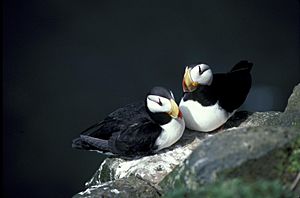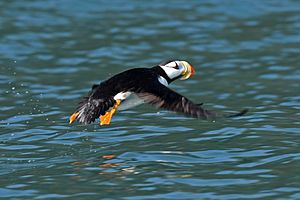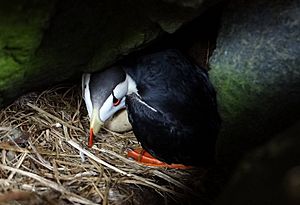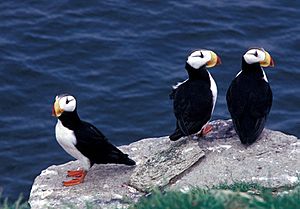Horned puffin facts for kids
Quick facts for kids Horned puffin |
|
|---|---|
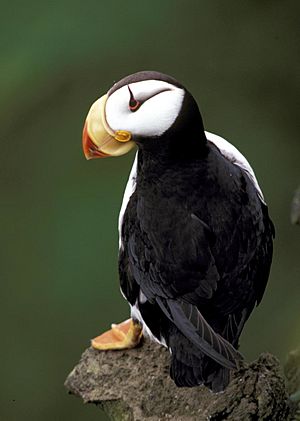 |
|
| Conservation status | |
| Scientific classification | |
| Genus: |
Fratercula
|
| Species: |
corniculata
|
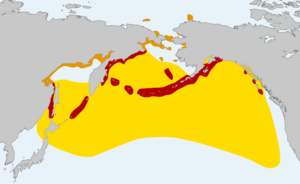 |
|
| Resident
Breeding visitor Winter visitor |
|
The horned puffin (Fratercula corniculata) is a cool seabird that lives in the North Pacific. You can find it along the coasts of places like Alaska, Siberia, and British Columbia. This bird spends most of its life out at sea, diving deep to catch fish. It builds its nests in big groups called colonies, often alongside other similar birds called auks.
It looks a lot like its cousin, the Atlantic puffin, which lives in the North Atlantic. But the horned puffin has a special black 'horn' above its eye, which gives it its name!
Contents
What's in a Name?
The scientific name for the horned puffin is Fratercula corniculata. Fratercula comes from a Latin word meaning "little friar." This is because their black and white feathers look a bit like the robes worn by monks.
Corniculata means "horn-shaped," which refers to the small black horn above the bird's eye.
The name "puffin" first came from a different bird, the Manx shearwater. People used to call its fatty, salted meat "puffin." Later, the name was given to the Atlantic puffin because it nested in similar ways. Eventually, it was used for the Pacific puffins too.
Different groups of people have their own names for the puffin. The Yup’ik people call it "qilangaq" or "qengacuar(aq)," meaning "little nose." The Ainu people of Sakhalin call it "etupirka," which means "beautiful beak."
About the Horned Puffin
Adult horned puffins are about 8 inches (20 cm) tall and weigh around 500 grams (1.1 pounds). Their wings can spread about 23 inches (58 cm) wide. Male and female puffins look the same.
Adult birds have a small, black, fleshy "horn" above each eye. This is where they get their name! They have white cheeks and a yellow patch at the base of their beak. Their legs and feet are bright orange.
The horned puffin's beak is larger than other puffin species. It's red at the tip and yellow at the base. During summer, when they are ready to breed, the outer layer of their beak grows bigger and becomes very bright yellow with a dark orange tip. This bright beak helps them attract a mate.
After summer, the bright outer layers of the beak fall off. Their face turns gray and black, and their legs and feet become a pale color. This is like a "winter coat" for their beak and face. Puffins can also see ultraviolet light, which helps them see a special glow on other puffins' beaks during courtship.
Young puffins have smoky-gray cheeks and a thin, black beak. Their feet are pinkish or grayish. They lose their gray spots in their first spring. Their beak grows and gets its bright colors over several years, becoming brightest when they are about five years old. This is when they are ready to have their own chicks.
Puffin Sounds
Horned puffins don't make many loud sounds. They mostly make quiet, guttural noises like cooing, roaring, or grunting. The most common sound is "arr-arr-arr." If they feel threatened, this sound gets faster, like "A-gaa-kah-kha-kha." These sounds are often made by adults and can sound like a distant chainsaw.
During mating season, they might make "Op-op-op-op-op" sounds. They are usually much quieter when they are out at sea.
Where Horned Puffins Live
The horned puffin is common in the northern Pacific Ocean. You can find them in places like the Shumagin Islands, the coast of Siberia, Kamchatka, Sakhalin, and the Kuril Islands. In North America, they live along the western coasts of Alaska and British Columbia, Haida Gwaii, and the Aleutian Islands. They are also found near the Chukchi Sea and on Wrangel Island.
Sometimes, they travel south to Japan or the coasts of Oregon and California. They don't migrate far for winter, but they do spend the colder months far out at sea.
Horned puffins like to live on steep rocky slopes and cliffs. Unlike some other puffins, they don't dig many burrows. Instead, they prefer to make their homes in rock crevices or under piles of rocks.
Puffin Behavior
How Horned Puffins Fly
To take off, horned puffins either jump off a cliff to get speed, or they run across the water until they can fly. They fly quickly and compactly, usually about 10 to 30 meters (33 to 98 feet) above the sea. Their wings beat constantly and rapidly.
They often fly in groups of two to fifteen birds, traveling between their nesting areas and places where they find food. Sometimes, they fly with tufted puffins or murres.
On Land
Horned puffins walk upright and use their claws to grip rocky surfaces. They can climb cliffs easily. When they run, they usually do so on soft ground, often near their nesting holes.
Horned puffins live and breed in large groups called colonies, which can have hundreds or even thousands of birds. When they land, they fly in circles above the colony first. Once on the ground, they might show if they are in charge or if they are being submissive to other birds.
A submissive puffin will briefly hold its legs slightly apart and spread its wings over its head for a few seconds. A dominant puffin will open its beak wide, lower its tongue, and puff up its back feathers. It might also step in place and rock from side to side. This is often done towards another puffin. The other puffin might back down or fight. During fights, puffins grab each other's beaks and hit each other with their wings. They might even tumble down a cliff while still fighting!
In the Water
Horned puffins spend half their time on the water, paddling with their feet. They are amazing swimmers underwater. Their movement underwater is so good, it's like they are "flying" through the water. Their strong wings act like oars, and their webbed feet work like a rudder. The water pressure helps their feathers stick to their body, making them streamlined. Puffins can easily stay underwater for more than a minute.
Like most seabirds, horned puffins have waterproof feathers. This helps them dive and keeps them warm. They have a special gland near their tail that makes an oily, waterproof liquid. The puffin spreads this liquid on its feathers with its beak, which helps it float and stay dry.
Food and Hunting
Adult horned puffins eat many different things. They feed on fish, small invertebrates, crustaceans, worms, and squid. They also eat small algae and marine plants.
To catch fish, horned puffins dive down to about 30 meters (98 feet), but they usually hunt at about 15 meters (49 feet deep). They often hunt in the early morning. They dive headfirst into the water, looking for schools of fish and watching out for predators. Once they spot prey, they chase it. A dive usually lasts between 20 and 30 seconds.
Puffins often swallow several small fish underwater before bringing the rest back to their colony. They don't take time to adjust the fish in their beaks, so they don't risk losing their meal.
Hunting areas are usually far from the nest. Horned puffins return with several small fish, squid, or crustaceans held in their special beaks. Young chicks eat a simpler diet, mostly sandeel or capelin caught near the coast. Parents feed their chicks two to six times a day. Unlike many other seabirds, horned puffins feed their chicks whole fish directly from their beak, not by throwing up food. Both parents help feed and raise the chick.
Life Cycle and Reproduction
Horned puffins are ready to have chicks when they are between five and seven years old. Their breeding season is from May to September. Horned puffin pairs stay together for life.
Courtship starts with the male and female swimming together on the water. The male will rise from the water, stretch his neck, and open and close his beak while jerking his head. The female will hunch down with her neck pulled in, close to the water. Then, they touch beaks, which is called "billing." A small head movement from both birds confirms they will be a pair for life. The male then gets on the female's back to mate, flapping his wings to stay balanced. After about 35 seconds, the female dives underwater and comes back up. Then, the pair flaps their wings together.
Pairs choose a nesting spot about a week after arriving at the breeding area. They prefer rock crevices. They clear a space and gather materials like grass and feathers to build their nest. Each pair lays only one egg per year. Most pairs in the same colony lay their eggs around the same time.
The egg is oval-shaped and off-white, with hints of lavender, gray, and brown. Both parents take turns sitting on the egg for about 41 days until it hatches. They then spend another 40 days raising the chick. The young puffin leaves the nest alone at night. It makes its way to the open water, then quickly dives and swims away to start its independent life.
Warmer ocean temperatures have actually helped horned puffins have more chicks.
Puffin Population
There are an estimated 1,200,000 horned puffins in total. About 300,000 are in Asia, and 900,000 are in North America. A large number, about 760,000, live in the Alaska Peninsula. In Alaska, nearly 250,000 puffins are spread across 608 different colonies, with the biggest one on Suklik Island. There are about 92,000 horned puffins in the Aleutian Islands, and nearly 300,000 live on the islands and coasts of the Sea of Okhotsk. The Chukchi Sea has a colony of 18,000 puffins, which is the largest in that area.
Images for kids
-
Four horned puffins in Kenai Fjords National Park, Alaska
See also
 In Spanish: Frailecillo corniculado para niños
In Spanish: Frailecillo corniculado para niños




